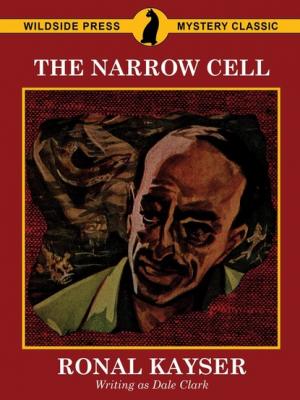The Narrow Cell. Ronal Kayser
Чтение книги онлайн.
Читать онлайн книгу The Narrow Cell - Ronal Kayser страница
 ection>
ection>
THE
NARROW
CELL
By DALE CLARK
The Narrow Cell
Copyright © 1944, renewed 1971, by Ronal Kayser.
All rights reserved.
Published by Wildside Press LLC
for Ruth
AUTHOR’S NOTE
It must be confessed that the City of San Diego, with its camouflage and aircraft plants and Market Street Police Headquarters, does exist in actuality; but the persons who are presumed to inhabit it for the purposes of this Tale are altogether the product of the writer’s invention.
As for La Jolla, the suburb hereinafter described is not the one to be found on any map; it lies closer to Baker Street than to Highway 101; it and its population are wholly fabricated for the Story’s sake.
When an author sets the stage of his Mystery in New York, Chicago, or London, it is conceded without any question that he does so because a stage must be set somewhere, and preferably among surroundings with which the writer is, and some few of his readers may be, familiar. The size of these cities lends impersonality; and no one supposes that the police officers and suspects attributed to such locales have any existence in the flesh. Smaller cities do not wear this cloak of impersonality, and it is a natural consequence that when people find such familiar scenes portrayed fictionally, they will scan the author’s pages in the expectation of finding their neighbors recognizably described therein.
Let me say at the outset that in these pages the search must prove a totally profitless exercise. No person described hereinafter has, or is intended to have, any resemblance whatsoever to any real person, living or dead; in San Diego or La Jolla, Mankato, or New Gilead, or anywhere else upon the terrestrial globe.
I have simply paid San Diego County the compliment (as I trust) of employing that locale for fictional purposes. I have borrowed the climate and some features of the scenery, and nothing else, and hope I have returned these in as good a condition as I found them.
DALE CLARK.
I
Grandfather had a simple rule . . . He said you could always tell a man’s character by what he laughed at.— THE AUTOBIOGRAPHY OF CATHERINE HOPE.
CAPTAIN HARRY WHIPPLE, special duty division commander, stood nearest the desk and picked up the phone.
“Halloa,” said he in a voice ripened by several highballs. “What? . . . Yeah, he’s here. John!”
Lieutenant John Kenmore came over from the group of plain clothes men who were toasting the departure of police chemist Earle Ames, lately commissioned into the United States Army Chemical Warfare Corps. The lieutenant was a tall man of spare and athletic figure. His grey eyes looked out of a face full of competence. It was a longish and rather angular face that coupled the chin of a stubborn fighter with the keen, reasoning glance of a strategist. As commanding officer in the Bureau of Internal Security of the San Diego Police Department, he ran the homicide detail and missing persons’ office, and, since Pearl Harbor, the war duty office as well.
“Yes. Kenmore speaking.”
“This is Henry Bowling—in La Jolla.” (Pronounced, of course, La Hoya.) “I suppose you remember me.”
Kenmore did; but it was a feat of trained memory. As war duty officer, he had come into contact with a host of civilian defense volunteers. But among the hundreds who had attended the police schools of instruction, Bowling stood out very slightly . . . A short, thick, red-faced man of pompous and self-important manner—Kenmore’s recollection placed him beside Dr. Lauren Wallace, the La Jolla incident officer.
The voice in the receiver said something about an “UXB lecture.” And that was it. Bowling had brought up some question about excavating a bombproof shelter in his backyard.
“You’re an air raid warden out there, aren’t you?” This was the sum and total of Lieutenant Kenmore’s recollection of Henry Bowling.
“Senior sector warden,” emphasized the voice.
Kenmore grinned. He recognized the pompous, the self-important manner. But it disappeared; the voice lowered to a pitch of sly, confiding, wheedling urgency.
“Look here, lieutenant . . . like to see you tonight. Say, if you could make it after the drill . . . eight o’clock. I want to introduce you . . . somebody you’ve been wanting to meet . . . long, long time . . .”
“Speech! Speech!” Across the room, Earle Ames had been hoisted to the top of another desk.
“What?” said Kenmore. “Just a minute.”
He looked around.
“Pipe down, you mugs, hold it.”
And then again, “What?”
Henry Bowling (if in fact it was he) did a surprising thing. He chuckled. And a moist, heavy, definitely unpleasant sound he made of it.
It was almost as if Kenmore were being kidded; but not quite that, either. It was a confidential chuckle, the lieutenant thought. He wasn’t being laughed at; he was invited to join in the jest.
Heh. Heh-heh.
“To hell with Hitler-hito,” declaimed the departing Ames, “is all I got to say.”
“I want to introduce you,” the voice in the phone confided, “to a murderer.”
“The murdering sons of bitches!” shouted Earle Ames.
“What’s that? Hello? Damn it!” cried Kenmore—into a dead wire.
His caller had hung up in the middle of a second, lumbrously risible chuckle.
Lieutenant Kenmore clenched the telephone in his fist, scowling.
It had certainly sounded like murderer.
Kenmore hesitated; reached for the desk directory; opened this to the suburban pages, and ran a forefinger down La Jolla’s B’s.
Bowling, Henry R. 222 Laguna Terrace. Seaview 3-3609.
He dialed.
No one at Seaview 3-3609 answered.
Now, he thought, what kind of a gag was that?
And answered himself: It was no gag at all.
How did he know?
He